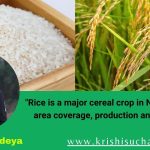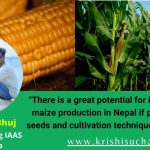Common methods of transplanting of rice seedlings in Nepal

Rice (Oryza sativa) is the major food crop in terms of production and economy and grown in all ecological regions of Nepal . In 2076/77 area under cultivation was 1458915 hector with productivity of 3804 kg/ha. Nepalese rice productivity – average of 3 tons/ha is very low compared with leading rice-producing countries and lower than in most South Asian countries (IRRI 2006). While rice cultivation is very important for Nepal’s farmers and its economy, high production costs together with continuing low productivity have made rice farming less profitable and less attractive in recent decades. Despite rapid population growth and considerable unemployment, in many rural areas labor shortages present an additional constraint for expanding agricultural production. So, it’s really crucial to discuss some new methodologies in techniques of rice cultivation to increase the yield in coming season.
Crop yield is totally dependent upon the quality of seedlings and method of transplantation implemented. Those prepared with proper guidelines seems to meet the targeted yield as per scientific recommendation. The major goals of seedbed preparation are to retain the maximum amount of soil moisture, control competing vegetation, improve seed to soil contact, and allow for the proper seeding depth, germination and emergence of the species to be seeded in the conservation planting.
Land preparation for main field
Wet preparation is the most common way of preparing lowland fields. In this method, the soil is tilled in a saturated or flooded condition. It helps improve weed control and facilitates incorporation of nutrients in the soil. With its nature, wet preparation has a high water requirement.
The following are the steps and processes involved in wet preparation:
- Repair or construct bunds
- Irrigate the field
- Perform primary tillage operations
- Flood the field
- Perform secondary tillage operations
- Level the field
The major objectives of puddling is to create physical, chemical and biological environment that enhance for growth and development of plant. Besides, it promotes mechanical mixing of organic manure and decomposition of weed and crop stubble. It is found that the wet bed in flooded condition reduce the germination and incidence of weed infestation in subsequent growing period.
Conditions to be fulfilled:
Age of seedling: 20-25 days for early varieties, 30-35 days for long duration varieties
Size of seedling: 15-20 cm height
Number of leaves in seedling: 3-4 leaves
Depth of transplanting: 2-3 cm depth, deep transplanting reduces the number of tillers and delays tillering by about 10 days.
Time of transplanting: it depends upon type of rice, land type, season of growing, climatic factors and varieties. The time of transplanting for main season is Ashar.
Spacing: depends upon varieties, time of transplanting, soil fertility and nutrient management
What is rice transplanting?
Transplanting is the most common and elaborative method of crop establishment for rice in Asia. Rice seedlings grown in a nursery are pulled and transplanted into puddled and leveled fields 15 to 40 days after seeding (DAS). Rice seedlings can either be transplanted manually or by machine. This is done in order to get higher yields and less weeding.
Why transplant rice?
Transplanting ensures a uniform plant stand and gives the rice crop a head start over emerging weeds. Further, seedlings are established even if the field is not leveled adequately and has variable water levels. Transplanting may also allow crop intensification as the crop is in the main field for less time.
Methods of transplanting
1. Manual method
1.1. Random method
In random method, seedlings are transplanted without a definite distance or space between plants. When transplanting is done at random, equal distances between hills are difficult to determine but it is essential that the estimated distances should not be too close or too wide (not less than 10 cm and not more than 25 cm) to complement control of weeds through early shading by rice canopies.
1.2. Straight-row Method
This method follows uniform spacing or pattern. Plant spacing is an important factor in transplanting rice. Proper spacing can increase the yield by 25−40% over improper spacing. You will also save money on inputs, labor, and materials. Straight rows facilitate management practices such as hand or rotary weeding and application of fertilizers, herbicides, or insecticides. Optimal plant spacing may also be achieved through this method. Transplant 2−3 seedlings of 15−21 days wet-bed or dry-bed grown seedlings at 20 x 20 cm spacing. Closer spacing (15 x 15 cm or 10 x 10 cm) may be used depending on the availability of planters and the cost of transplanting. This is advantageous when weed control is inadequate.
2. Mechanical method
Mechanical transplanting requires considerably less time and labor than manual transplanting. One hectare of land requires 1 person day to establish.
Different type of transplants with varying levels of complexity and sizes can be used, such as:
- two-row walk behind models
- eight-row ride-on models
The rice field must be well prepared for machine transplanting.
- Raise seedlings in special mat nurseries or in seedling trays. Use 18−25 kg of good seed per 100 m2 of nursery for each ha. Seedlings will be ready for transplanting in 15−21 days after seeding (DAS).
- Ensure that fields are well puddled and leveled.
- Drain fields and allow mud to settle for 1−2 days after the final puddling.
- The subsurface soil layers need to be hard enough to support the transplanting machine.
- The soil is ready when a small “V” mark made in the puddled soil with a stick holds its shape. At this moisture level, the soil can hold the seedlings upright.
- Soil should not be so dry that it sticks to and interferes with planting parts or wheels of the transplanter.
- Load the seedling mats on the machine and transplant the seedlings at the selected machine setting.
How to prepare seedlings for mechanical transplanting?
Mechanical transplanters have built-in trays or seedling boxes. Grow seedlings on a thin layer of soil in 30 cm x 60 cm trays per seedling box. In some instances, seedlings are grown on larger areas and then cut into rectangular strips (mats of seedlings) that fit into the planting trays of the transplanter.
System of Rice Intensification (SRI) : SRI is a set of agronomic principles and practices that were proposed originally by civil society actors, Fr. Henri de Laulanie and the farmers in Madagascar, to improve the production of irrigated rice for poor and resource-limited household. SRI was first introduced in Nepal in 1998 with some initial trials in Khumaltar . Nepal was one of the first countries outside Madagascar where SRI methods were piloted.
SRI is based on three principles:
Alternate wetting and drying: Rice field soils should be kept moist rather than continuously saturated, as this improves root growth and supports the growth and diversity of aerobic soil organisms.
Wider spacing: Rice plants should be planted singly and spaced optimally widely to permitmore growth of roots and canopy and to keep all leaves photosynthetically active. Spacing is between 25 to 40 cm.
Transplanting young seedlings: Rice seedlings should be transplanted when young, less than 15 days old with just two leaves, quickly (within 30 minutes), shallow and carefully, to avoid trauma to roots and to minimize transplant shock.
Advantages :
- Lowers seed requirement by 90%
- Reduces irrigation water requirement by 50%
- Low use of chemical fertilizer, this technology promotes use of organic manure
- Higher number of tiller and Increase in yield.
Transplanting ensures a uniform plant stand and gives the rice crop a head start over emerging weeds. Further, seedlings are established even if the field is not leveled adequately and has variable water levels. Transplanting may also allow crop intensification as the crop is in the main field for less time. Transplantation enables selective cultivation of healthy seedling. This results in better crop production. Besides, it permits better root penetration into the soil and allows better shoot development.
Writer: Abhishes Basel (Student, Bsc. Ag IAAS Paklihawa Campus)

 दिल्लीको होटलमा बसेर क्यानडा र अमेरिकामा मानव तस्करी
दिल्लीको होटलमा बसेर क्यानडा र अमेरिकामा मानव तस्करी  अनलाइन जुवा खेलाएर काभ्रेका अनिलले गरे दुई अर्बको कारोबार
अनलाइन जुवा खेलाएर काभ्रेका अनिलले गरे दुई अर्बको कारोबार  मुख्यमन्त्री सोडारीले विश्वासको मत लिन सुदूरपश्चिमको प्रदेश सभा बैठक आव्हान
मुख्यमन्त्री सोडारीले विश्वासको मत लिन सुदूरपश्चिमको प्रदेश सभा बैठक आव्हान  अफगानिस्तानमा बाढीबाट ३१५ भन्दा बढीको मृत्यु
अफगानिस्तानमा बाढीबाट ३१५ भन्दा बढीको मृत्यु  सुँगुरको मिर्गौला प्रत्यारोपण गरिएका रिचर्डको निधन
सुँगुरको मिर्गौला प्रत्यारोपण गरिएका रिचर्डको निधन 



Great piece of work man..
Great piece of work man..